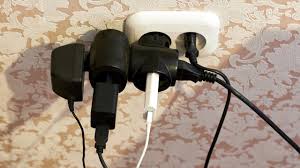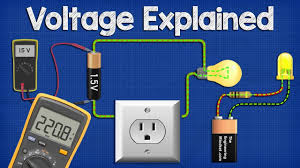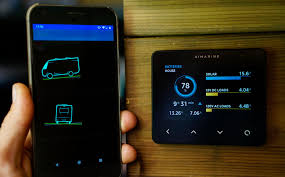Residential Electrical Explains Converters and Voltage
Many people who travel to or from the United States run into problems when they try to use electronics like a laptop or hair dryer. This is because the American 110 volt power system is different than the European 220 volt electricity. Without a converter, devices can fail or become damaged. Even the electrical system in use can be damaged. Always use caution when operating devices in another country and check the voltage before plugging them in.
Voltage Difference between US and Europe
The United States is one of the only countries that currently use the 110 volt / 60 hertz electrical system. Most countries use a higher voltage system that handles 220 volts at 50 hertz. Appliances and electronics in these countries are designed to only work with the electrical system in that area. Because the voltage in Europe is twice that of the American system, plugging American devices into a European electrical system without a converter can destroy the device and even cause a fire. Devices intended for the 60 hertz cycle may not be able to function on the 50 hertz system as well.
Using Products Abroad
Using your devices in another country often requires the use of a converter. To see if the device needs a converter, check the information panel. Many manufacturers design electronics to work with range of voltages and these products will list acceptable input levels as 110-240 volts. If a specific voltage is required, the item needs a converter to work outside this range. Always look at the wattage requirement of the product before buying a converter. A residential electrician can recommend a good converter that has a higher wattage rating than the device, which prevents malfunction.
Advantages of the 220 Volt System
Although it has more safety risks, the 220v system used throughout Europe can reduce energy use and the electrical load.
There is no clear winner between the 110 volt and 220 volt electrical systems. It is important to remember the differences and risks, however, when traveling to a different country. Using electrical devices on a system they were not made for can cause fires or cause the device to malfunction or break. A trained residential electrician can recommend the right converter to use electrical items on any voltage system.

How do I increase voltage in my home?
You need to
find out if the AC voltage to your house is “normal” or if it
has drooped to a lower value due to large current demand in the
neighborhood. It is the task of the power company to supply the normal
voltage to your house. If it is too low, they need to fix
something. In principle you could use a step-up transformer to raise the
voltage, but a transformer big enough to handle the load current of an air
conditioner could be expensive. I would not try that first.
Now, if the voltage to your house is normal, you may have an air conditioner
that is intended for use with a different voltage. Like trying to run a
220V input unit from 110V (if you are in the USA). Or maybe the air
conditioner has a leak and has lost coolent. More input voltage won’t
help with that.

How to Convert 120v to 240v? Voltage Converter Application
120V (110v)
outlet can power virtually any standard device you can imagine, from tiny
handheld electronics to large appliances. However, the item you want to use may
require the higher 240V (220v, 230v) outlet. Fortunately, converting your
outlet from 120V to 240V is a relatively simple project. Moreover, buying a
reliable voltage converter will make the job even easier.
Gather Your Tools, and Turn Off the Power
The tools needed to convert an 120V wall outlet to a 240V outlet include
screwdrivers, a neon voltage tester, and a black marker. You also need a 240V
receptacle and a double-pole circuit breaker. Turn off the power at the main
circuit breaker to avoid electrocution while you are working. Even with the
power off, the terminals and wires on the main breaker carry an electrical
charge, so you should never touch them for any reason.
Remove and Disconnect the Outlet Breaker and Wires
Locate the specific terminal that governs the 120v outlet, and loosen it with
the screwdriver. Next, remove the wire connected to the terminal. Carefully pop
the breaker off of the panel, and set it aside. Locate the neutral terminal by
following the white wire, and loosen the screw. Pull the wire off the bus bar,
and color the last few inches of the wire with your black marker. This makes
the wire easier to identify and easier for our 120v to 240v converting job.
Install the Double-Pole Circuit Breaker
Hook the two tabs on the back of the 120v double-pole circuit breaker to the
lock bar inside the breaker panel. Press the tabs firmly, and immediately
switch the new breaker off. Locate the two terminal screws on the new breaker
and loosen them. Slide the wire previously connected to the old breaker into
one terminal and tighten it. This step must be done carefully, in order to
achieve 120V transform to 240V.
Install the 240V Receptacle
Slide the prongs of the neon voltage tester into the existing socket to ensure
it does not contain a current. If the lamp on the tester doesn’t light up, you
can proceed. Remove the screw holding the 120V outlet cover in place, and pop
it off. Remove the screws holding the receptacle in place, and slide it out of
the electrical box. Remove the white, black, and ground wires from the
receptacle by loosening the screws on the corresponding terminals. Locate the
green ground terminal on the new outlet, wrap the end of the ground wire in a
clockwise U-shape around the screw, and tighten it firmly. After this step, we
finally managed the operation of 120V to 240V converting.
Test the Device
Turn the power back on at the main service panel, slide the prongs of the neon
voltage tester into the new socket, and test to ensure it is working.
Additional lamps will light up to indicate the new, higher rating. Be sure that
the new breaker only covers the new 240V outlet, since more coverage can cause
electrical or operation problems with additional powered components. Now, you
can safely use your appliance on the 120V to 240V power outlet.

How do I know if my device is single voltage?
If you see something on the power label that looks more like 110V AC or 120V AC, it’s a single voltage device. Single voltage devices require a plug adapter AND a voltage converter and/or a transformer for international travel. To determine now what model of converter you’ll need, you will have to figure out the wattage of your device and purchase a voltage converter that complements that. Read on for all you need to know about watts.
Watts: Watts (W) measure how much power a device uses. You can find out the wattage of your device by looking for the W on the power label.
A low-watt range is typically 23W to 50W, which is usually the wattage range of the most common travel electronics. But many heating devices needing a higher setting can consume between 1000W and 2000W. You need to know the wattage of your device in order to determine the appropriate voltage converter to purchase so look on the indications label of your device for the W to get this information. Then, be sure to buy a converter with a wattage rating that is two to three times higher than the device you plan to operate in order to safely convert. For example, for an appliance rated at 400 watts, you should get a converter that is at least 800 watts.
What Would Cause Low Voltage in House Wiring?
One of the most common causes of low voltage is the overload of the system. Different times of the day, such as early afternoon, are typically high demand times. As is well known, hot days and weeks of the summer can cause a surge of power demand for air conditioners, a very power hungry set of machines. When the power company detects a large surge in demand, it will engage in the standard 5 percent reduction in power per home in a region. This can be a cause for under- or weak voltage.
Less well known is the concept of distance. Utility Systems Technologies in New York issued a paper in September 2009 dealing with both the causes and solutions to low voltage issues. One of the claims made is that homes at a great distance from the main power plant or generator will receive a lower amount of voltage than homes that are closer. This is particularly the case in spread-out rural areas. The problem here is “low load density.” This means that electricity must travel farther. In urban areas where people live close together, the increased density of “thickness” of the electrical signal is conducive to higher, or at least more regular, voltage per home.